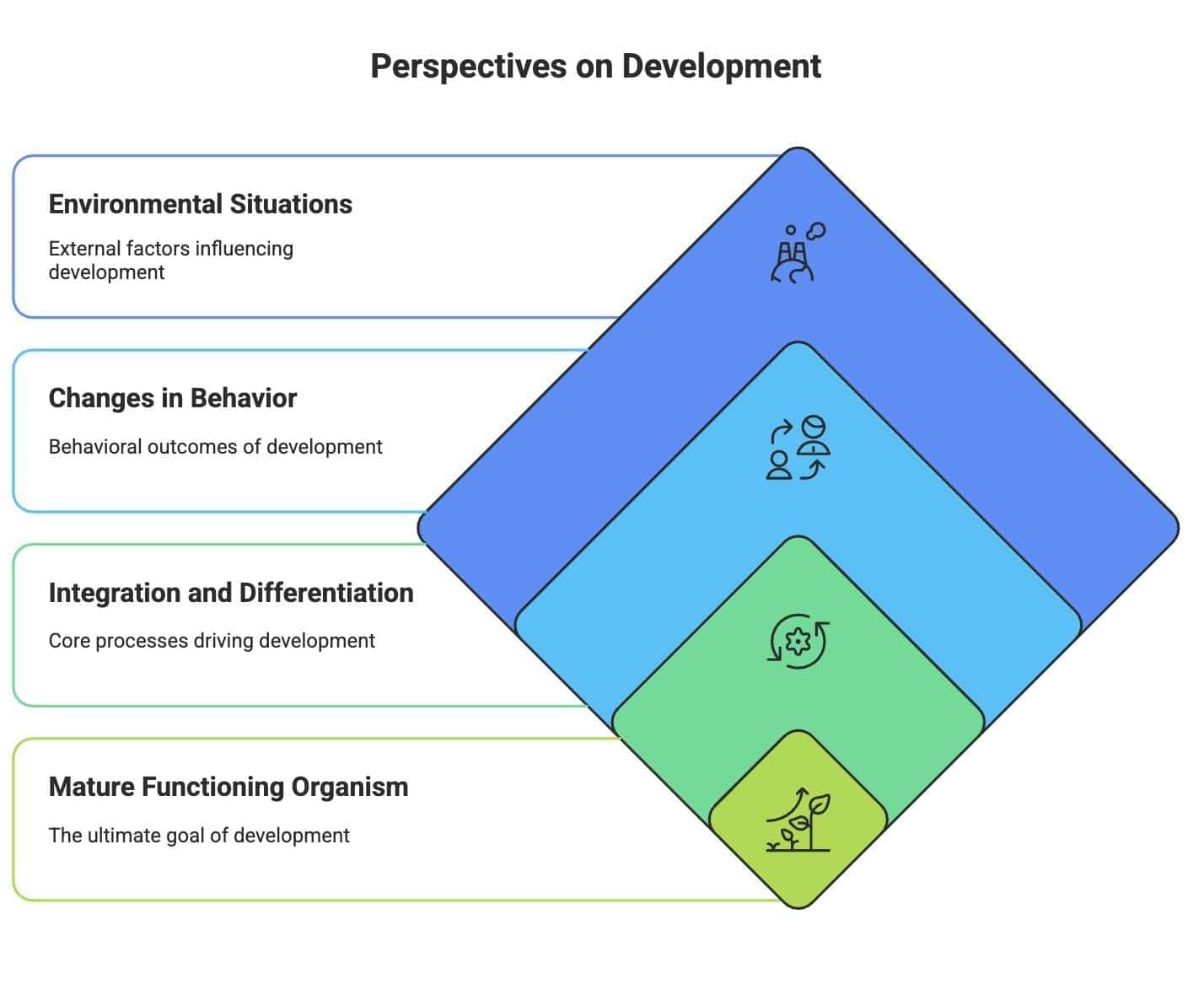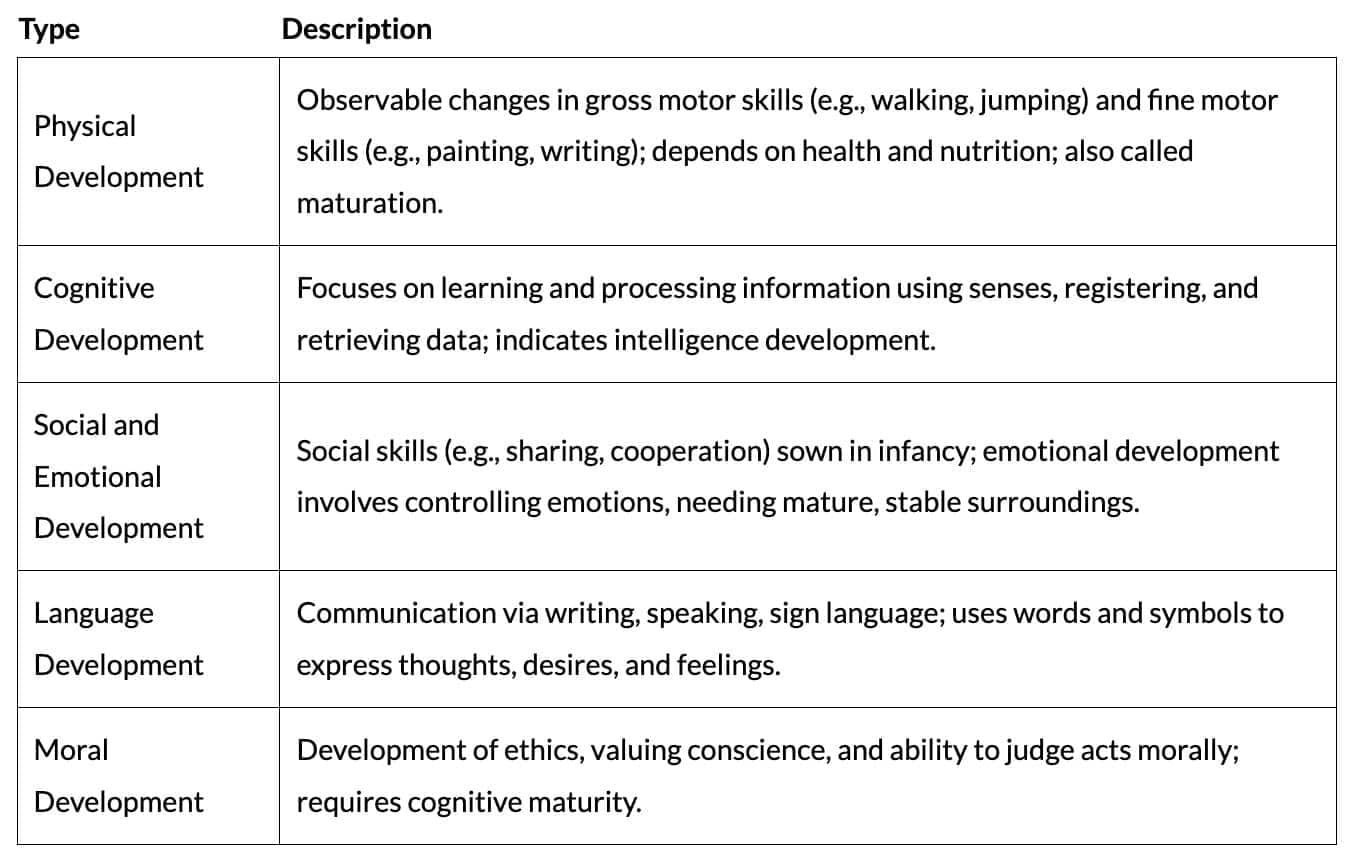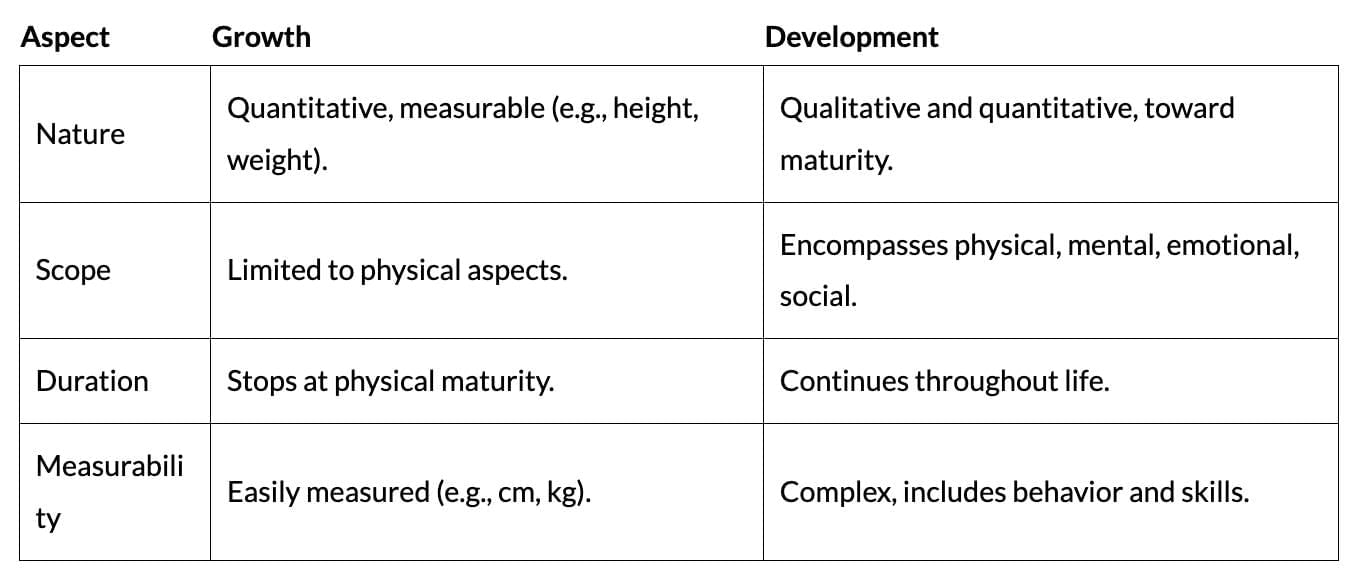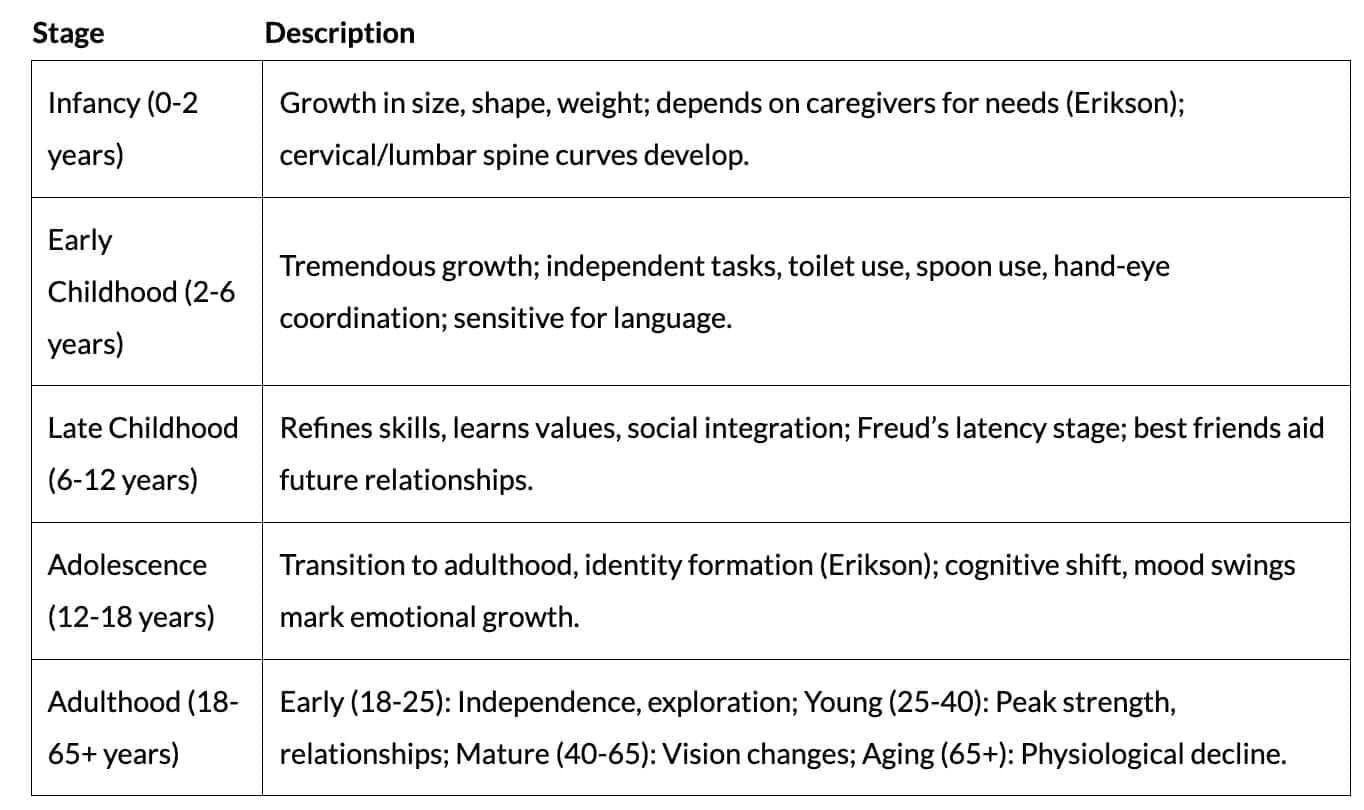CTET & State TET Exam > CTET & State TET Notes > Child Development and Pedagogy for CTET Preparation > Cheat Sheet: Development & Its Relationship with Learning
Cheat Sheet: Development & Its Relationship with Learning | Child Development and Pedagogy for CTET Preparation - CTET & State TET PDF Download
| Table of contents |

|
| Introduction |

|
| Definitions of Development |

|
| Growth |

|
| Stages of Human Development |

|
| Learning |

|
Introduction
The term 'development' refers to qualitative and quantitative changes occurring alongside growth, progressing toward maturity. This cheat sheet explores the concept of development, its characteristics, types, stages, and the role of learning, providing a concise overview for understanding human growth and behaviour.
Definitions of Development
- Jersild, Telford, and Sawrey: "Development refers to the complex set of processes involved in the emergence of a mature functioning organism from a fertilised ovum."
- E. Hurlock: "Development is not limited to growing larger. Instead, it consists of a progressive series of changes towards the goal of maturity."
- J.E. Anderson: "Development is concerned with growth as well as those changes in behaviour which result from environmental situations."
- Heinz Werner: "Development consists of two processes: integration and differentiation."

Characteristics of Development
- Continuous process from conception to maturity.
- Follows an orderly sequence: Infancy → Early Childhood → Late Childhood → Adolescence → Maturity.
- Involves both qualitative (e.g., personality) and quantitative (e.g., height) changes, inseparable in nature.
- Complex phenomenon influenced by factors like physical attributes, intelligence, and sex.
- Rate of development is predictable but not precise (e.g., slow learner vs. superior child).
- Individuals differ in pattern and rate due to heredity and environmental influences.
Types of Development

Growth
- Definition: Increase in weight, height, and body proportions; involves growth of muscles and the ability of parts to function.
- Herbert Spencer: Refers to physical growth as "big and heavy."
- Focuses on quantitative changes, measurable over time (e.g., height increase).
Differences Between Growth and Development

Factors Responsible for Growth and Development
- Heredity: Biological transmission of traits (e.g., height, intelligence, eye color) from parents to offspring.
- Environment: Sum of physical and psychological influences from conception; can enhance heredity.
- Nutrition: Essential for physical and mental growth; malnutrition harms development.
- Sex: Boys and girls differ in growth patterns; girls mature faster in adolescence.
- Early Stimulation: Encourages potential (e.g., talking to babies, storybooks); unstimulating settings limit growth.
- Child Rearing: Permissive parenting may cause poor responsibility; democratic/firm parenting aids adjustment.
Stages of Human Development

Learning
- Definition: "Any relatively permanent change in behaviour from practice and experience."
- E.L. Thorndike: "Learning is a gradual process where the individual makes many attempts to learn."
- Crow and Crow: "Learning involves the acquisition of habits, knowledge, and attitudes."
Relationship Between Learning and Development
- Distinction: Development concerns the structure of knowledge; learning is triggered by situations, teachers, or external factors.
- Interaction: Learning awakens development via social interactions; growth aids learning about surroundings.
- Impact: Learning and development mutually influence mental and behavioural adjustments for survival.
Solved Examples
- Identifying Development Type: A 4-year-old child learns to catch a ball and write her name. Classify these changes.
Solution:- Catching a ball: Physical Development (gross motor skill, coordination).
- Writing her name: Physical Development (fine motor skills, hand control).
- Stage of Development: A 14-year-old explores new roles, experiences mood swings, and questions values. Identify the stage.
Solution:- Age 14, role exploration, mood swings, and value questioning align with identity formation and cognitive/emotional shifts.
- Matches Adolescence (12-18 years) per Erikson’s theory.
- Factors Impacting Growth: A child grows taller but lags in problem-solving. Suggest two factors affecting this.
Solution:- Height growth: Influenced by Heredity (genetic traits from parents) and Nutrition (diet supports physical growth).
- Poor problem-solving: Limited Early Stimulation (lack of puzzles, learning activities) or an unstimulating Environment.
- Growth vs. Development: A child gains 5 cm in height and learns to share toys. Differentiate these changes.
Solution:- Height gain (5 cm): Growth—quantitative, physical, measurable change.
- Learning to share: Development—qualitative, involves social skills, behaviour change.
- Learning and Development Link: A 6-year-old interacts with peers, improving cooperation and reasoning. Explain the process.
Solution:- Interaction with peers: Learning—acquiring cooperation via practice, experience.
- Improved reasoning: Development—cognitive growth from social exposure.
- Learning (peer interaction) awakens developmental processes, enhancing behaviour and adjustment.
The document Cheat Sheet: Development & Its Relationship with Learning | Child Development and Pedagogy for CTET Preparation - CTET & State TET is a part of the CTET & State TET Course Child Development and Pedagogy for CTET Preparation.
All you need of CTET & State TET at this link: CTET & State TET
|
67 videos|154 docs|42 tests
|
FAQs on Cheat Sheet: Development & Its Relationship with Learning - Child Development and Pedagogy for CTET Preparation - CTET & State TET
| 1. What is the difference between growth and development? |  |
Ans.Growth typically refers to a quantitative increase in size, quantity, or capacity, such as physical growth in children or economic growth in a country. Development, on the other hand, encompasses qualitative changes that lead to improved wellbeing and capabilities, such as cognitive, emotional, and social advancements. While growth can be a part of development, development is a broader concept that includes various dimensions of change.
| 2. What are the characteristics of development? |  |
Ans.Development is characterized by several key features, including multidimensionality, as it affects various aspects of life such as social, emotional, cognitive, and physical growth. It is also a lifelong process, occurring through various stages from infancy to adulthood. Additionally, development is influenced by both internal factors (like genetics) and external factors (such as environment and culture), and it is often goal-oriented, aiming for improvements in quality of life and human potential.
| 3. What are the stages of human development? |  |
Ans.Human development is commonly categorized into several stages: infancy (birth to 2 years), early childhood (2 to 6 years), middle childhood (6 to 12 years), adolescence (12 to 18 years), and adulthood (18 years and older). Each stage is characterized by specific developmental milestones and changes that shape individuals' physical, cognitive, and socio-emotional abilities.
| 4. How do factors influence growth and development? |  |
Ans.Factors influencing growth and development include genetic predispositions, nutritional status, access to healthcare, socio-economic conditions, education, and cultural influences. For instance, a supportive environment that provides adequate nutrition and education can enhance development, while adverse conditions may hinder growth and limit potential. The interaction between these factors plays a critical role in overall human development.
| 5. What is the relationship between learning and development? |  |
Ans.Learning and development are closely intertwined, as learning often drives development. Through learning experiences, individuals acquire new skills, knowledge, and behaviors that contribute to their cognitive and social development. Conversely, development can also enhance learning capacity, as more advanced cognitive abilities enable more complex learning. This reciprocal relationship underscores the importance of fostering both learning opportunities and developmental support in various contexts.
Related Searches















